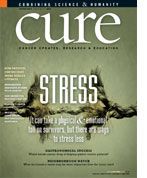Publication
Article
CURE
Best Face Forward for Head and Neck Cancer Care
Author(s):
Today patients with head and neck cancer are benefiting from a multidisciplinary team for treatment.
When 16th-century astronomer Tycho Brahe lost part of his nose in a duel, his prosthesis options were limited—he donned a folded metal plate in the shape of a nose to cover his missing anatomy.
Today, patients with head and neck cancer, who may lose bone, skin, teeth, or cartilage as a result of cancer surgery, find that the focus is not only on cancer control, but also on facial restoration. This evolved functional and aesthetic approach to treatment, with a multidisciplinary team of specialists concentrated on a certain area within the full scope of facial prosthetic rehabilitation, can be life-changing for patients.
Joseph Huryn, DDS, says he has patients who were recluses for years, unaware of facial prosthetics as a possibility. “It changes their life incredibly,” says Huryn, chief of dental service at Memorial Sloan-Kettering Cancer Center in New York City.
Depending on the cancer’s location, size, and treatment, maxillofacial prostheses can be intra-oral (within the mouth) or extra-oral (outside of the mouth). Maxillofacial prosthodontists can fabricate prostheses ranging from a resection appliance—used to replace part of the lower jaw—to an auricular (ear) prosthesis or an orbital prosthesis replacing the eye and surrounding tissues including the eyelid, socket, and sometimes part of the cheek and nose. Professionals in anaplastology—the art and science of creating artificial anatomy—specialize in the fabrication of extra-oral prostheses such as eyes, ears, noses, and limbs.
A multidisciplinary team works with the patient and surgeon from the beginning, expanding the cancer treatment focus to include functional rehabilitation and quality of life, according to Betsy Davis, DMD.
“The team approach is critically important because it incorporates a comprehensive treatment with rehabilitation so patients have a better outcome,” says Davis, director of the division of maxillofacial prosthetics at the Medical University of South Carolina in Charleston.
“The reconstructive surgeon, the dental/maxillofacial prosthodontist, the oral surgeon, and the speech and swallowing pathologist work as a team on the rehabilitation of the patient.”
The surgeon removing the tumor and the maxillofacial prosthodontist or the anaplastologist creating the prosthesis determine the best approach before the surgery, deciding whether the prosthesis will be attached with adhesive, anchored to osseointegrated implants (screws placed in the bone beneath the skin), or held in place by virtue of design.
Tissue engineering and three-dimensional medical imaging with computer-aided design and manufacturing technology will propel future developments, says Huryn, who sees a day when the patient’s own bone will be encouraged to grow into the matrix that is generated by a computer and have the same shape as before surgery.
Read the complete article, originally published in Heal Winter 2007.






